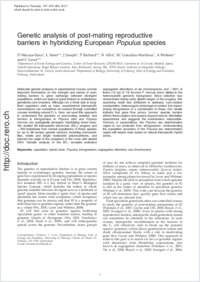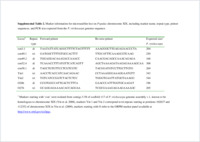Genetic analysis of post-mating reproductive barriers in hybridizing European Populus species
- Macaya-Sanz, David Department of Forest Ecology and Genetics, Center of Forest Research, CIFOR-INIA, Carretera de A Coruña, Madrid, Spain
- Suter, Leonie Jodrell Laboratory, Royal Botanic Gardens, Kew, Richmond, Surrey, UK - ETH Zürich, Institute of Integrative Biologie, Switzerland
- Joseph, Jeffrey A. Jodrell Laboratory, Royal Botanic Gardens, Kew, Richmond, Surrey, UK
- Barbará, Thelma Jodrell Laboratory, Royal Botanic Gardens, Kew, Richmond, Surrey, UK - Department of Biology, University of Fribourg, Unit of Ecology and Evolution, Switzerland
- Alba, N. Department of Forest Ecology and Genetics, Center of Forest Research, CIFOR-INIA, Carretera de A Coruña, Madrid, Spain
- González-Martínez, S. C. Department of Forest Ecology and Genetics, Center of Forest Research, CIFOR-INIA, Carretera de A Coruña, Madrid, Spain
- Widmer, Alex ETH Zürich, Institute of Integrative Biologie, Switzerland
- Lexer, Christian Jodrell Laboratory, Royal Botanic Gardens, Kew, Richmond, Surrey, UK - Department of Biology, University of Fribourg, Unit of Ecology and Evolution, Switzerland
-
18.05.2011
Published in:
- Heredity. - 2011, vol. 107, p. 478–486
English
Molecular genetic analyses of experimental crosses provide important information on the strength and nature of post-mating barriers to gene exchange between divergent populations, which are topics of great interest to evolutionary geneticists and breeders. Although not a trivial task in long-lived organisms such as trees, experimental interspecific recombinants can sometimes be created through controlled crosses involving natural F₁'s. Here, we used this approach to understand the genetics of post-mating isolation and barriers to introgression in Populus alba and Populus tremula, two ecologically divergent, hybridizing forest trees. We studied 86 interspecific backcross (BC₁) progeny and >350 individuals from natural populations of these species for up to 98 nuclear genetic markers, including microsatellites, indels and single nucleotide polymorphisms, and inferred the origin of the cytoplasm of the cross with plastid DNA. Genetic analysis of the BC₁ revealed extensive segregation distortions on six chromosomes, and >90% of these (12 out of 13) favored P. tremula donor alleles in the heterospecific genomic background. Since selection was documented during early diploid stages of the progeny, this surprising result was attributed to epistasis, cyto-nuclear coadaptation, heterozygote advantage at nuclear loci experiencing introgression or a combination of these. Our results indicate that gene flow across ‘porous’ species barriers affects these poplars and aspens beyond neutral, Mendelian expectations and suggests the mechanisms responsible. Contrary to expectations, the Populus sex determination region is not protected from introgression. Understanding the population dynamics of the Populus sex determination region will require tests based on natural interspecific hybrid zones.
- Faculty
- Faculté des sciences et de médecine
- Department
- Département de Biologie
- Language
-
- English
- Classification
- Biological sciences
- License
-
License undefined
- Identifiers
-
- RERO DOC 27881
- DOI 10.1038/hdy.2011.35
- Persistent URL
- https://folia.unifr.ch/unifr/documents/302004
Other files
Statistics
Document views: 135
File downloads:
- pdf: 378
- Supplementary material: Tables 2, 3: 127
- Supplementary material: sheet 1: 52
- Supplementary material: sheet 2: 54
- Supplementary material: sheet 3: 47


